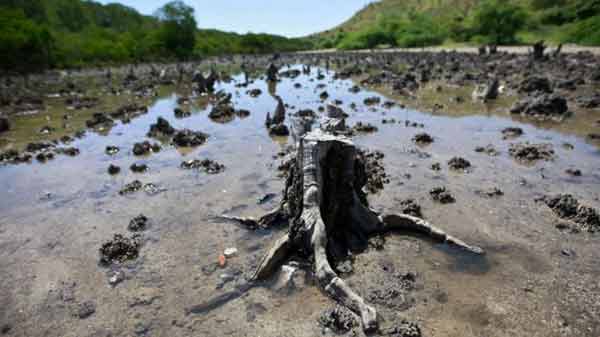
Singapore city, Singapore (BBN)-The threat posed by the development of rice and palm oil plantations to mangroves in South-East Asia has been underestimated, a study has suggested.
Rice and oil plantations accounted for 38 per cent of mangrove deforestation between 2000 and 2012, the research showed.
As well as being important carbon sinks and rich in biodiversity, mangrove forests provide fuel and food for coastal communities.
The findings appear in the Proceedings of the National Academy of Sciences.
"Aquaculture has largely been held responsible for causing mangrove deforestation, particularly in countries like Thailand and the Philippines," explained co-author Daniel Richards from the National University of Singapore.
He told BBC News that a study of eight countries around the world between the 1970s and the early 2000s found that 54 per cent of deforested mangroves were replaced with aquaculture ponds used for fish or shrimp/prawn production.
"Our study found that aquaculture was still important but we were surprised that in South-East Asia between 2000 and 2012, just 30% of deforested mangroves were replaced with aquaculture.
"The impact of other drivers, like rice and oil palm agriculture, was greater than we expected."
MANGROVES - NATURAL DEFENCES
•Mangroves are salt-tolerant evergreens that grow along coastlines, rivers and deltas
•Found in more than 120 tropical and subtropical nations
•The plants' root systems have been shown to dissipate wave energy
Dr Richards observed: "Almost 25,000 hectares of Myanmar's mangroves were converted to rice paddy between 2000 and 2012."
He added that while there had been a few previous studies that had highlighted the role of oil palm production as a cause for mangrove loss, they had no idea of the scale of the deforestation.
"Sixteen percent of all deforested mangroves in Southeast Asia were replaced with oil palm plantations during our study period," he said.
"We usually think of oil palm as an issue which affects tropical forests on land but our study shows that demand for oil palm is also driving deforestation in coastal mangrove forests."
'VERY THREATENED'
Dr Richards and his colleague, Daniel Friess, used Google Earth to monitor how land was used once mangrove forests had been felled.
"We viewed [more than] 3,000 deforested mangrove patches, and recorded the land-use that they were replaced with," Dr Richards said.
"This study also builds on some great existing data sets that were provided by scientists at the University of Maryland and the US Geological Survey."
He warned that mangrove forests in the region were "very threatened":
"Our study focused on quite a recent period of time but mangroves in South-East Asia have experienced widespread deforestation for decades.
"Previous research suggests that around 90% of Singapore's original mangrove forests have been lost."
The region is home to about one third of the world's mangroves, including some of the most biodiverse.
The researchers said mangroves were important to people because they provide fish and crabs, wood and charcoal, and can help protect coastlines from erosion.
Mangrove forests also stored very high densities of carbon so had a role in regulating carbon in the atmosphere, they added.
In other regions, such as Sri Lanka, the value of intact mangrove forests has been recognised by authorities and measures have been put in place to protect them.
GROWING AWARENESS
Dr Richards said that the importance of mangrove forests is becoming better understood, but it was a slow process.
"It is encouraging that our study found low rates of mangrove deforestation in Vietnam, the Philippines, and Brunei, and this is partly due to stronger protection of mangroves in these countries.
"There are initiatives to restore mangroves in some countries: the Mangrove Action Project in Thailand, and Blue Forests in Indonesia, are working with governments and local communities to protect and restore mangrove forests."
But he warned that more needed to be done: "Indonesia has more mangrove forests than any country in the world, and the mangroves in the more remote parts of the country, such as Indonesian Papua, are almost intact.
"However, these mangroves may be at risk of deforestation [as a result of] recent plans to grant concessions and develop the agriculture industry in this region.
"If we want to protect Indonesia's remaining mangroves then we need to act quickly."
BBN/SK/AD